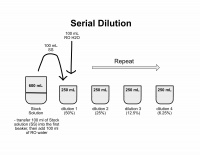Difference between revisions of "Water Lab"
Jump to navigation
Jump to search
| Line 19: | Line 19: | ||
:d) The instructor will not reveal the identify of the water samples. | :d) The instructor will not reveal the identify of the water samples. | ||
| − | ==Part | + | ==Part 4: Molarity, Dilutions, and Personal Taste Threshold== |
As a group, make the following 3 solutions (generally one at a time): | As a group, make the following 3 solutions (generally one at a time): | ||
Latest revision as of 18:23, 13 March 2017
Welcome to the Water Lab
The purpose of this lab activity is to expose the student to concepts of ion solubility, chromatography, and concentration.
Part 1: Water Sampling
At your lab bench you will find 4 water samples labeled A, B, C, and D. All of these water samples have come from potable (drinkable) sources.
- a) Label a plastic cup A, B, C, and D and collect a sample from each.
- b) Sample (taste) the waters and make notes about your perception and preference...ON YOUR OWN/NOT A GROUP DISCUSSION.
- c) Now, as a group discuss your findings.
- d) Once your group has discussed the finding, the instructor will provide you with a list of the water sources and as a group assign letters to water source.
Part 2: Ion Chromatography Data
Part 3: Build a Conductivity Meter
- a) As a group, construct a conductivity meter using the materials at your bench; diagram here.
- b) Test the water samples from Part 1; enter conductivity info in lab notebook.
- c) Review your "assignments" above and reassign if necessary.
- d) The instructor will not reveal the identify of the water samples.
Part 4: Molarity, Dilutions, and Personal Taste Threshold
As a group, make the following 3 solutions (generally one at a time):
- (suggestion: do all of your calculations now)
- a) Make 200 mL of a 0.04 M NaCl (aq) solution.
- b) Make 200 mL of a 0.001 M citric acid (aq) solution.
- c) Make 200 mL of 0.04 M sucrose or fructose (aq) solution.
- d) Make a serial dilution of each sample above. This is explained in the figure below.
- e) Sample (taste) the solution in the order of least concentrated to most. At which concentration are you able to "detect" the flavor.
Summarize your finding in your lab notebook and then turn in your carbon copies.
